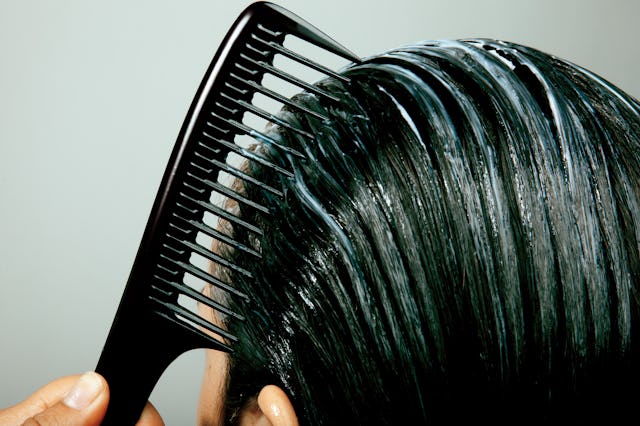How To Choose The Right Hair Mask For You, According To Experts
Which ingredients and marketing terms you should shop for, depending on your hair type.

When you walk down the hair aisle at the store, there’s, oh, I dunno, approximately one bazillion different products to choose from. Everyone’s hair needs are different so of course there’s a variety of products available, but if you’re specifically shopping for hair masks, they can kind of all start to sound the same. Here’s how to choose the right hair mask for you — and spoiler, it depends on your hair’s texture and what it is exactly that you’re trying to fix.
For starters, consider your goals.
Are you focusing on growing out your hair and improving your scalp’s health? “I prefer using natural and organic ingredients that will help cleanse the scalp and stimulate the hair follicles,” says celebrity hairstylist and Pura D'Or partner Clyde Haygood.
If you’ve recently color-treated your hair and are noticing dryness, that’s a great time to try a hydrating or reparative hair mask, says Lunabelle Walker, hair colorist and stylist for OVERTONE. “Lifting hair to light blondes can be damaging at times, especially for anyone with a deeper, darker base natural color. A hair mask is a perfect way to protect hair from further damage.”
Especially if your hair has been bleached, Haygood says to shop for masks with “oils such as coconut, argan, rosemary, olive, castor, E, grapeseed, tea tree, and shea butter” to prevent dryness and promote elasticity. Biotin and keratin-containing masks would be better for strengthening the hair, he adds.
Walker says folks with curly or textured hair may also feel like their hair needs a hydration boost from time to time, which can help guide you to more nourishing masks, preferably one with botanical oils, she says.
How To Choose The Right Mask For You, Using Your Hair Texture
If you don’t have a specific goal in mind but want to find a fitting mask to add into your routine every now and then, what should you look for? Here’s what each hair type should seek out in their perfect hair mask, according to Linda Gattineri, owner of Equo Co. salon based in Del Mar, California.
Fine hair
Fine strands crave hydration without heaviness, Gattineri says. “Look for lightweight humectants like hyaluronic acid, aloe, or silk proteins that add softness and movement. The ideal consistency is a light lotion or gel-cream that rinses clean. On the packaging, seek words like ‘weightless repair’ or ‘volumizing moisture.’ Steer clear of ‘ultra-rich’ or ‘buttery,’ which is usually code for formulas that will flatten your style.”
Thick or coarse hair
Coarse textures do best with richer formulas, she says. “Reach for shea butter, mango butter, avocado or argan oil, and ceramides, all of which provide the deep slip and smoothing power this hair type needs. A dense, buttery consistency ensures every strand is coated. Marketing terms like ‘intense hydration’ and ‘frizz-defying’ are your green light. Words like ‘weightless’ usually mean it won’t be nourishing enough.”
Coily or curly hair
Curly girl should reach for oil-rich hair masks — think castor, jojoba, coconut, or olive oils paired with humectants like glycerin or aloe, Gattineri says. “The texture should be thick and creamy with slip, perfect for detangling. Look for packaging that promises ‘moisture lock’ and ‘curl definition.’ Skip anything that says ‘volumizing.’ Curls don’t need extra lift, they need nourishment.”
Straight hair
Straight hair shows everything, Gattineri says, from shine (or lack thereof) to frizz to flatness. You’ll want to choose masks that combine a light protein (rice, silk, or panthenol) with mid-weight oils like argan or grapeseed, she advises.
“A smooth, silky cream consistency works best. Labels that boast they’re ‘shine-boosting,’ ‘sleek,’ or ‘anti-frizz’ usually align with what this hair type needs. Beware of ‘ultra-buttery’ claims, which can weigh strands down.”
Wavy hair
Waves fall in between the needs of curly and straight hair. “Seek aloe, flaxseed, or lightweight oils like argan or jojoba alongside balanced proteins,” Gattineri says. “A cream-gel hybrid texture is ideal — hydrating yet airy. Packaging that reads ‘texture enhancing’ or ‘hydrating but weightless’ is spot on. Avoid ‘extra-rich’ formulas that can smother waves into straightness.”
Color-treated or damaged hair
No matter what your natural hair texture is, Gattineri says color-treated hair benefits most from bond repairing products. “Look for bis-aminopropyl diglycol dimaleate, maleic acid, or amino acids, plus ceramides and antioxidants for strength and shine,” she says. “The consistency can vary by texture, but the packaging should promise ‘bond repair,’ ‘strengthening,’ or ‘color protection.’”